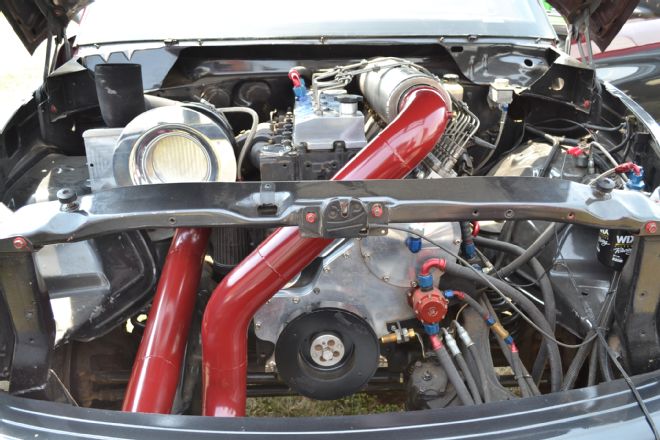 | 002 Rob 26 Puller Engine Bay
When you pop the hood on Rob Wright’s ’95 Dodge Ram 2500 sled puller, one of the first things you might notice is its lack of a cooling system. Since both the engine block and cylinder head are filled with Hard Blok, a radiator and water pump are not needed.
| 002 Rob 26 Puller Engine Bay
When you pop the hood on Rob Wright’s ’95 Dodge Ram 2500 sled puller, one of the first things you might notice is its lack of a cooling system. Since both the engine block and cylinder head are filled with Hard Blok, a radiator and water pump are not needed.
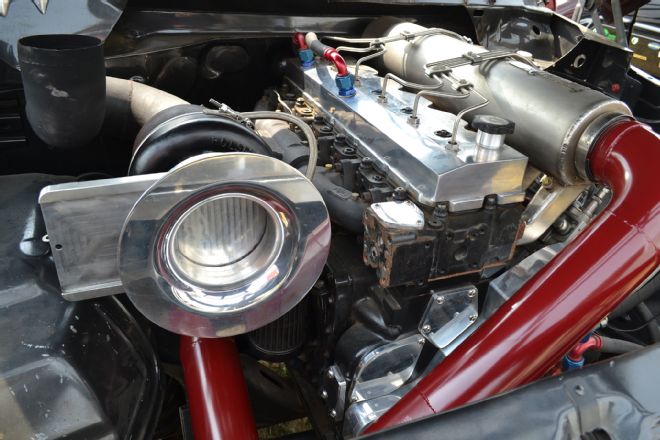 | 003 Rob 26 Puller 1300hp Engine
Class-specific engines for sled pullers are some of the most advanced diesels on the planet. With 1,300 hp out of a 6.4L Cummins engine and a single turbocharger, Rob Wright's powerplant makes 3.3 hp per cubic inch!
| 003 Rob 26 Puller 1300hp Engine
Class-specific engines for sled pullers are some of the most advanced diesels on the planet. With 1,300 hp out of a 6.4L Cummins engine and a single turbocharger, Rob Wright's powerplant makes 3.3 hp per cubic inch!
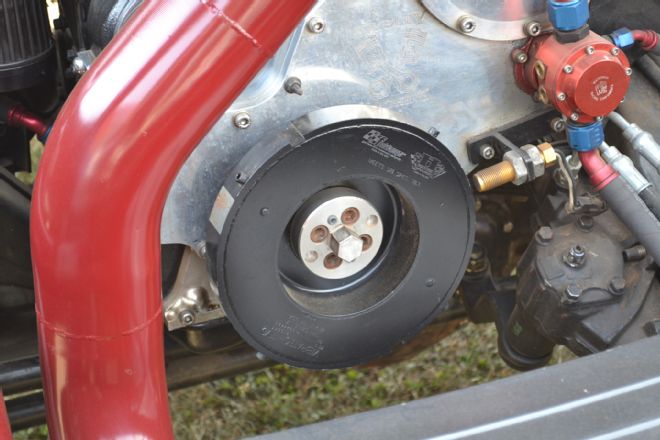 | 004 Rob 26 Puller Dampener
A strong bottom end is vital for a pulling engine’s longevity over the course of a full season. The 6.4L is founded on a sleeved and deckplated 6.7L block, with an internally balanced crankshaft, a set of “custom” rods, Ross Racing pistons, and a custom flat-tappet camshaft. An SFI-rated Fluidampr balancer keeps harmonics in check when the engine is turning 4,000 to 4,500 rpm.
| 004 Rob 26 Puller Dampener
A strong bottom end is vital for a pulling engine’s longevity over the course of a full season. The 6.4L is founded on a sleeved and deckplated 6.7L block, with an internally balanced crankshaft, a set of “custom” rods, Ross Racing pistons, and a custom flat-tappet camshaft. An SFI-rated Fluidampr balancer keeps harmonics in check when the engine is turning 4,000 to 4,500 rpm.
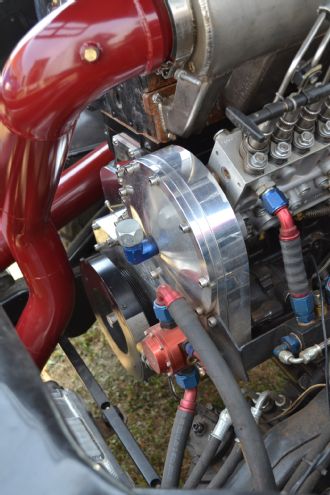 | 005 Rob 26 Puller Front Cover
The mixture of mechanical and common-rail fueling parts requires some custom pieces. A big part of making everything work is the front cover, which adapts the P-Series injection system to the newer 6.7L block.
| 005 Rob 26 Puller Front Cover
The mixture of mechanical and common-rail fueling parts requires some custom pieces. A big part of making everything work is the front cover, which adapts the P-Series injection system to the newer 6.7L block.
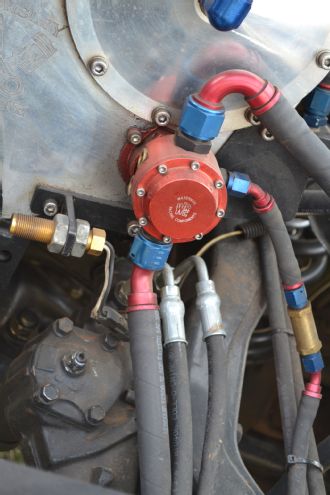 | 006 Rob 26 Puller Lift Pump
The fuel system is one area that is extremely overbuilt, as a pressure drop (to the high-dollar injection pump) can spell disaster for the engine. The Waterman Racing Components pump is driven by the crankshaft, supplies up to 100 psi, and can flow a crazy 600 gallons per hour.
| 006 Rob 26 Puller Lift Pump
The fuel system is one area that is extremely overbuilt, as a pressure drop (to the high-dollar injection pump) can spell disaster for the engine. The Waterman Racing Components pump is driven by the crankshaft, supplies up to 100 psi, and can flow a crazy 600 gallons per hour.
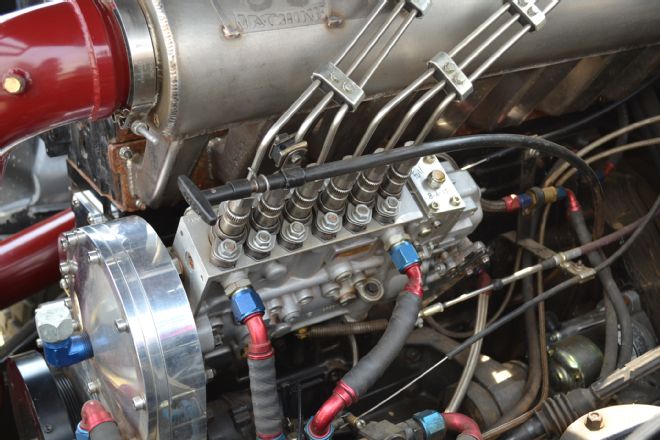 | 007 Rob 26 Puller Northeast 13mm Pump
Although it’s P-Series based, the 13mm Northeast Diesel Service injection pump is highly modified. It allows full fueling up to 5,000 rpm and is set at 650 cc per 1,000 strokes of fuel, although it’s capable of flowing much more.
| 007 Rob 26 Puller Northeast 13mm Pump
Although it’s P-Series based, the 13mm Northeast Diesel Service injection pump is highly modified. It allows full fueling up to 5,000 rpm and is set at 650 cc per 1,000 strokes of fuel, although it’s capable of flowing much more.
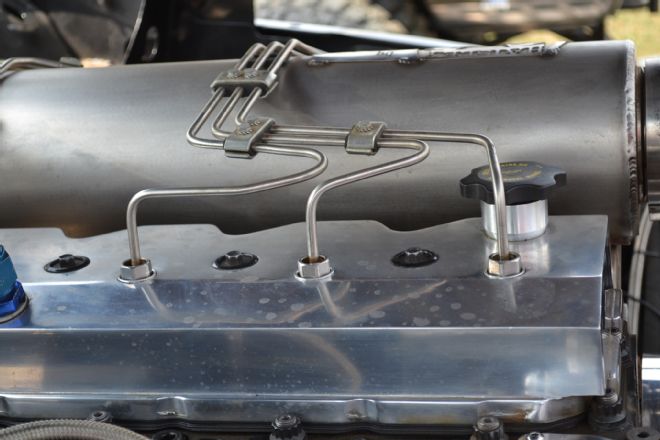 | 008 Rob 26 Puller Top Feed Injectors
Rob is pretty tight-lipped about the specs of the wild MJ Tool and Fab top-feed injectors, but he hints that they flow somewhere in the range of 800 percent more than stock.
| 008 Rob 26 Puller Top Feed Injectors
Rob is pretty tight-lipped about the specs of the wild MJ Tool and Fab top-feed injectors, but he hints that they flow somewhere in the range of 800 percent more than stock.
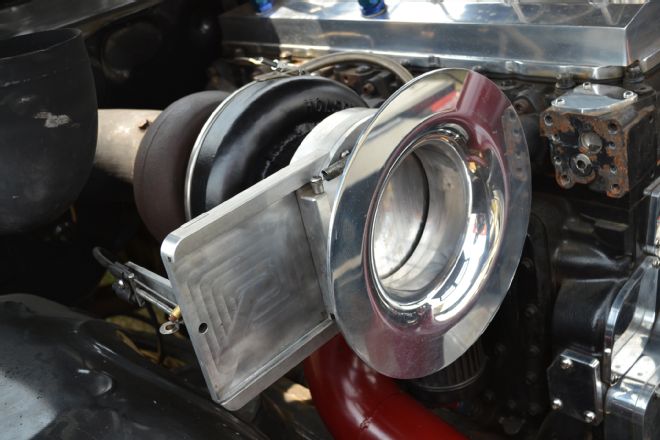 | 009 Rob 26 Puller HX60 Based Turbo
A long time on an engine dyno was spent getting the turbocharger just right. The Holset HX60-based turbo features a custom compressor wheel that’s clipped down to 2.6-inch (66mm) specs, along with a unique race cover. Rob estimates the custom unit is worth about 200 to 300 more horsepower than an out-of-the-box turbo!
| 009 Rob 26 Puller HX60 Based Turbo
A long time on an engine dyno was spent getting the turbocharger just right. The Holset HX60-based turbo features a custom compressor wheel that’s clipped down to 2.6-inch (66mm) specs, along with a unique race cover. Rob estimates the custom unit is worth about 200 to 300 more horsepower than an out-of-the-box turbo!
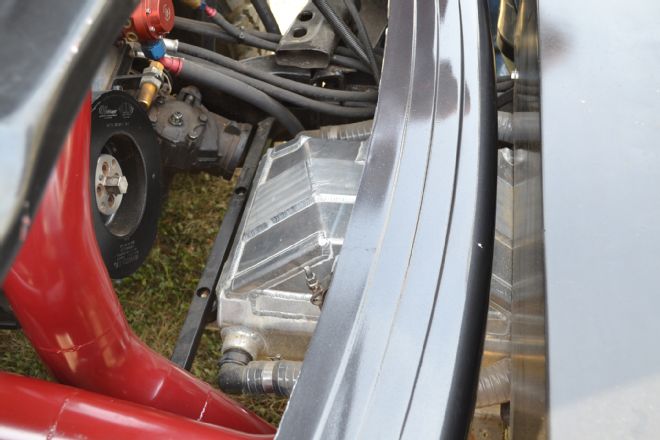 | 010 Rob 26 Puller Air To Water Intercooler
The more weight at the front of the truck, the better. So a huge, Chiseled Performance four-core air-to-water intercooler is mounted where the radiator used to sit. The ’cooler chills 500-plus-degree compressor air to slightly above ambient temperature.
| 010 Rob 26 Puller Air To Water Intercooler
The more weight at the front of the truck, the better. So a huge, Chiseled Performance four-core air-to-water intercooler is mounted where the radiator used to sit. The ’cooler chills 500-plus-degree compressor air to slightly above ambient temperature.
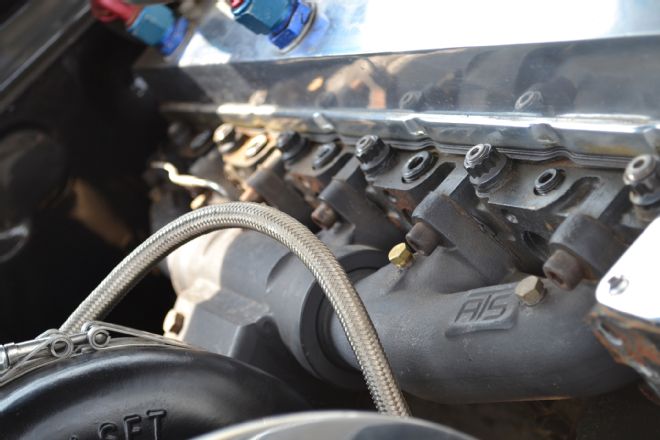 | 011 Rob 26 Puller ATS Manifold And 14mm Studs
Some parts on Rob's engine are quite exotic. The head studs are 14mm instead of 12mm and are made from ARP's 625 Custom Age material. The 24-valve head is also ported and polished, and its fitted with oversize valves, Smith Brothers pushrods, titanium valvesprings, and billet rocker bridges. Oddly enough, the rocker arms are stock, and Rob says he's never had a problem with them.
| 011 Rob 26 Puller ATS Manifold And 14mm Studs
Some parts on Rob's engine are quite exotic. The head studs are 14mm instead of 12mm and are made from ARP's 625 Custom Age material. The 24-valve head is also ported and polished, and its fitted with oversize valves, Smith Brothers pushrods, titanium valvesprings, and billet rocker bridges. Oddly enough, the rocker arms are stock, and Rob says he's never had a problem with them.
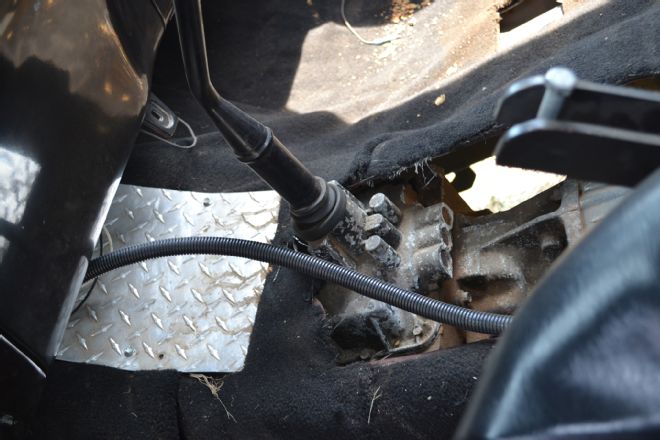 | 012 Rob 26 Puller NV4500 Transmission
Perhaps one of the least trick parts on Rob's Dodge Ram is the NV4500 five-speed manual transmission, which is just as the factory built it—with the exception of an oversize Haisley Machine input shaft and triple-disc clutch. Rob launches in Fourth Gear and never shifts during an entire pull.
| 012 Rob 26 Puller NV4500 Transmission
Perhaps one of the least trick parts on Rob's Dodge Ram is the NV4500 five-speed manual transmission, which is just as the factory built it—with the exception of an oversize Haisley Machine input shaft and triple-disc clutch. Rob launches in Fourth Gear and never shifts during an entire pull.
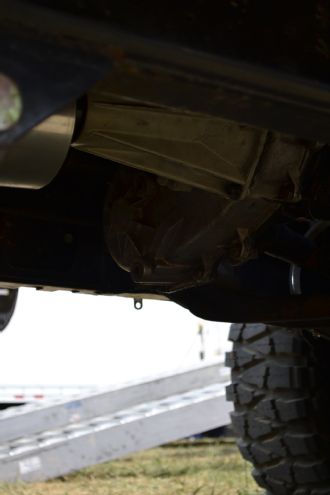 | 013 Rob 26 Puller Transfer Case
Rob modified the 241DHD transfer case to remain locked in 4-Low.
| 013 Rob 26 Puller Transfer Case
Rob modified the 241DHD transfer case to remain locked in 4-Low.
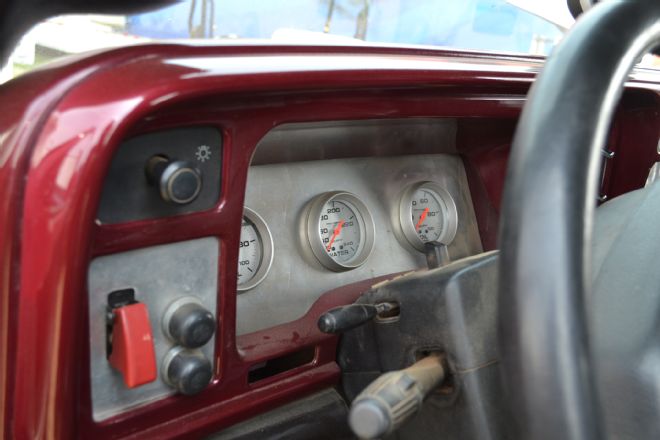 | 014 Rob 26 Puller Gauges
The dash in the ’95 Dodge Ram 2500 isn't full of gauges or a sophisticated data logger. “We spend so much time on the dyno, we already know just about everything the engine does during a pull,” Rob explains.
| 014 Rob 26 Puller Gauges
The dash in the ’95 Dodge Ram 2500 isn't full of gauges or a sophisticated data logger. “We spend so much time on the dyno, we already know just about everything the engine does during a pull,” Rob explains.
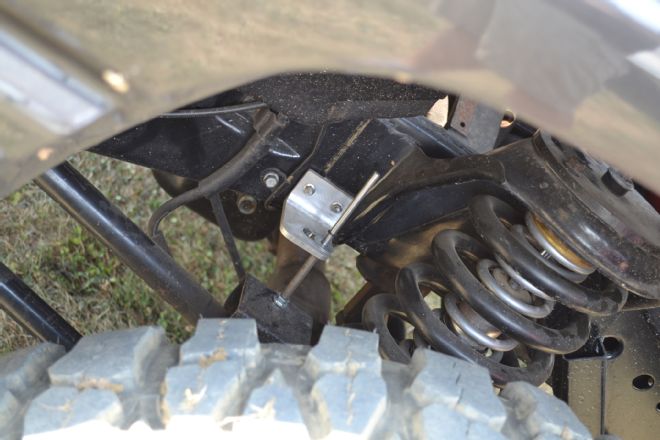 | 015 Rob 26 Puller Front Double Coil Over Suspension
Rob isn't afraid to try new things to keep his truck at the top of the pack. The front suspension is a unique double-coilover setup, with a normal coilover shock inside of a factory-style coil spring. The theory behind this setup is that it's extremely variable in its damping rates, which helps the truck hook as it shifts its weight from front to back multiple times while headed down track.
| 015 Rob 26 Puller Front Double Coil Over Suspension
Rob isn't afraid to try new things to keep his truck at the top of the pack. The front suspension is a unique double-coilover setup, with a normal coilover shock inside of a factory-style coil spring. The theory behind this setup is that it's extremely variable in its damping rates, which helps the truck hook as it shifts its weight from front to back multiple times while headed down track.
With the change to an open driveline, look for the 2.6 Class to be more competitive than ever, as breakage becomes less of a factor. In the next few years, we wouldn't be surprised to see power levels climb even further as well, to as high as 1,400 and 1,500 hp. One thing's for sure, though: As technology progresses, so will Rob and hisl’95 Dodge Ram 2500.
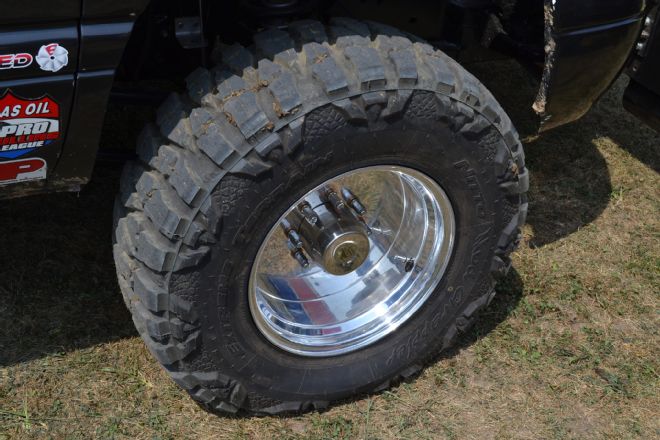 | 016 Rob 26 Puller Front Nitto Mud Grapplers
“The person who gets to the 100-foot mark with the most speed usually has a good chance of winning,” Rob says. To help the front end hook out of the hole, Rob runs aggressive 35x12.50R17 Nitto Mud Grapplers, which are mounted on 17x10 Real Racing Wheels.
| 016 Rob 26 Puller Front Nitto Mud Grapplers
“The person who gets to the 100-foot mark with the most speed usually has a good chance of winning,” Rob says. To help the front end hook out of the hole, Rob runs aggressive 35x12.50R17 Nitto Mud Grapplers, which are mounted on 17x10 Real Racing Wheels.
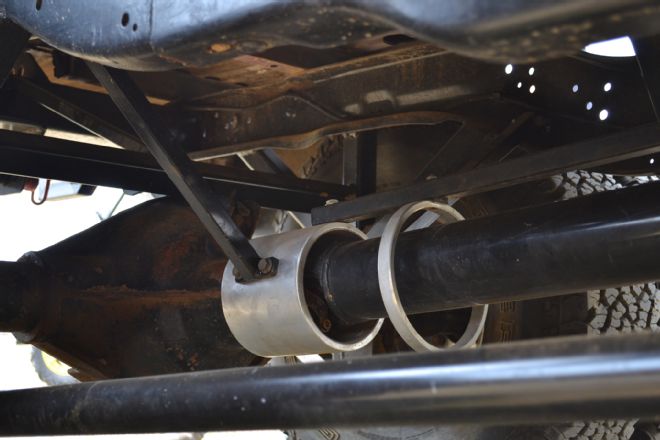 | 017 Rob 26 Puller Dana 80 And Driveshaft Loop
A reinforced Dana 80 rearend with a Liberty's High Performance Products custom spool and 37-spline Branik Motorsports axles resides in the rear of the truck. The Dana 60 up front has a Yukon Gear and Axle Grizzly locker and 37-spline Branik Motorsports inner axles. The driveshaft loops are there in event of driveline or rearend breakage occurring, which seems to be frequently.
| 017 Rob 26 Puller Dana 80 And Driveshaft Loop
A reinforced Dana 80 rearend with a Liberty's High Performance Products custom spool and 37-spline Branik Motorsports axles resides in the rear of the truck. The Dana 60 up front has a Yukon Gear and Axle Grizzly locker and 37-spline Branik Motorsports inner axles. The driveshaft loops are there in event of driveline or rearend breakage occurring, which seems to be frequently.
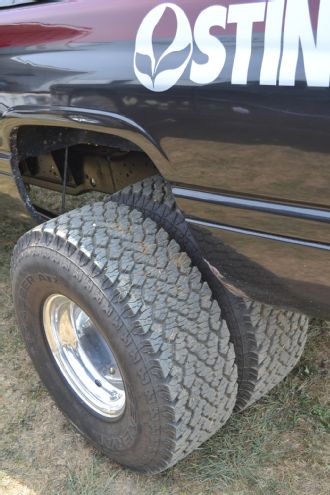 | 018 Rob 26 Puller Rear Dual General Grabber AT
Virtually all sled pullers in the 2.6 Class (and up) run dual rear wheels when the rules allow it. For traction at the rear of his truck, Rob relies on four 35x12.50R17 General Grabber All-Terrain tires on 17x10 Real Racing Wheels.
| 018 Rob 26 Puller Rear Dual General Grabber AT
Virtually all sled pullers in the 2.6 Class (and up) run dual rear wheels when the rules allow it. For traction at the rear of his truck, Rob relies on four 35x12.50R17 General Grabber All-Terrain tires on 17x10 Real Racing Wheels.
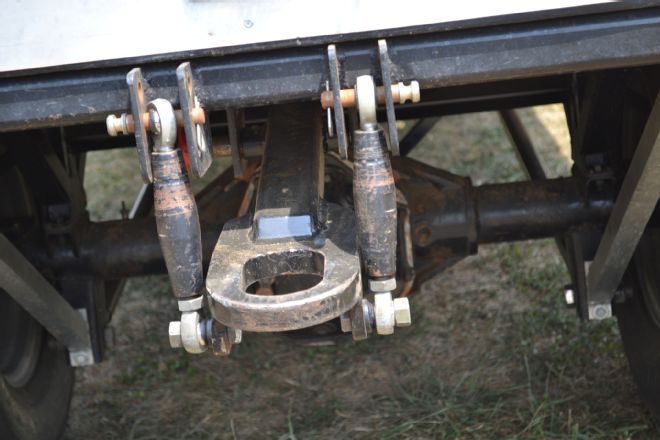 | 019 Rob 26 Puller Hitch
Hitches are usually one part of the equation that pullers are pretty quiet about, and Rob is no exception. Rob says Jason O'Brien at Performance Truck and Tractor has been a big help with chassis advice.
| 019 Rob 26 Puller Hitch
Hitches are usually one part of the equation that pullers are pretty quiet about, and Rob is no exception. Rob says Jason O'Brien at Performance Truck and Tractor has been a big help with chassis advice.